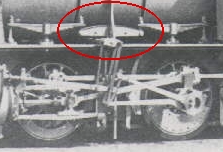Equalising beam

Equalising beam on a Prussian T 3
An equalising beam, equalising lever or equalising bar[note 1] (German: Ausgleichshebel or Ausgleichhebel) links the suspension of two or more adjacent axles of a vehicle with more than two axles, especially railway locomotives. Its job is to provide 'compensated' springing,[1] i.e. to ensure an even and statically determinate distribution of load to all the axles on uneven terrain or poorly laid track. The function of an equalising lever thus corresponds roughly to that of axle compensators or rockers (Achswippen).

Railcar bogie, with equalising beam
Notes[]
- ^ Or "equalizing" beam,etc.
References[]
- ^ Semmens, P.W.B. and Goldfinch A. J. (2003). How Steam Locomotives Really Work, Oxford and New York, OUP, pp. 242-243. ISBN 978-0-19-860782-3.
Categories:
- Automotive suspension technologies
- Rail technologies
- Locomotive stubs